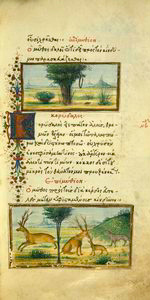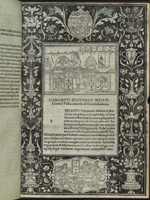Section One
1 PSALTER
Psalter with Canticles and Prayers
Manuscript in Greek; tempera, gold, and ink on parchment
Unidentified (provincial?) monastic scriptorium, Byzantium, middle or second
half of 13th century
Spencer Collection, Greek Ms. 1
The psalter held a prominent place in the Byzantine liturgy,
and miniatures were frequently included in more opulent copies
to accompany the 151 Psalms of King David and a series of Canticles
or Odes (Psalm-like songs), excerpted from other books of the
Bible. This thirteenth-century Psalter is the work of
a single anonymous scribe and, as usual, one or more unnamed
artists, who possibly worked in a provincial monastic scriptorium.
It contains twenty-one miniatures, seven of which are full-page,
placed before and within the text of the Psalms and immediately
before the first Ode. Each Psalm also begins with an ornamental
initial.
Since they were not working with a narrative form in the Psalms,
Byzantine artists commonly did not create their paintings as
illustrations to passages in the text, but instead provided
psalters with a set of portraits or scenes from the lives of
David or of Moses.
This manuscript is open to the full-page frontispiece of “King
David with Five Musicians” (fol. 1v), which shows the bearded
David in the guise of a Byzantine emperor, gesturing and holding
a book, and with a nimbus surrounding his head. The musicians
are playing the cymbals, a lute, a square harp, a long horn,
and a drum. Opposite, as the headpiece to Psalm 1, is “Christ
in Majesty” (fol. 2r).
The manuscript may be seen as a reflection of the revival
of the tradition of manuscript illumination and the other visual
arts following the defeat of the Latin Empire and restoration
in 1261 of Byzantine sovereignty upon the entry of Emperor
Michael VIII Palaiologos (reigned 1259–82) into Constantinople.
2 LITURGY
Liturgy of the Greek Orthodox Church
Manuscript in Greek; tempera,
gold, and dark brown ink on paper
Unidentified monastic scriptorium,
Wallachia, Romania(?), end of the 16th–first half of the
17th century
Spencer Collection, Greek Ms. 3
A late manuscript indebted to the Byzantine tradition, this
liturgical book was written and decorated in the style of Luke,
metropolitan of Wallachia (a principality of Romania on the
lower Danube River), who was a native of Cyprus, where he learned
calligraphy, and whose career is documented from 1588 to 1626.
It is written in a large rounded archaizing “baroque” liturgical
minuscule script. The single anonymous scribe probably had
apprenticed with Luke or with scribes of his circle, identified
as the Wallachian school of calligraphy but as yet not well
studied.
The decoration includes four headpieces and numerous large
initials incorporating fusions of fantastic animals, dragons,
snakes, birds, angels, plants, and flowers painted in an array
of rich colors and heightened with gold. Both the script and
ornamentation of Spencer Ms. 3 are similar stylistically to
a manuscript copied by Jacques de Ganochora, one of Luke’s
students.
The curator of this exhibition wishes to acknowledge the indispensable,
new documentation on The New York Public Library’s manuscripts
in Greek provided by Dr. Nadezhda Kavrus-Hoffmann, whose research
will be a part of a future comprehensive publication on the
Library’s illuminated manuscript holdings.
3 GOSPEL BOOK
Orthodox Eastern Church. Evangelion
Theion kai Hieron Euangelion ... kai aphierothen to potemakariotato
kai sophotato patriarche Ierosolymon kyrio kyrio Chrysantho
to Notara. Hen Etiesi
Venice: Antonio Bortoli for Nikolaos Saros, 1745
Spencer Collection
From the late fifteenth through the eighteenth century, Venice
remained the most vital center for presses printing in Greek,
with their books largely marketed to Greeks living under Ottoman
rule. This Gospel Book was published at the press founded by
Nikolaos Saros, one of the two most important Greek presses
in Venice in the seventeenth century. Acquired in 1706 by Antonio
Bortoli, the press supposedly continued to operate under Saros’s
name until Bortoli’s debt was paid. Unusual for its lavish
adornments, the Gospel Book was among the approximately 315
books published with Saros’s printer’s mark. It is dedicated
to Chrysanthos Notara, Patriarch of Jerusalem and all Palestine,
who may have been its recipient; it was undoubtedly intended
as a present for a high church dignitary.
The volume contains four full-page woodcuts of the Evangelists
(signed C [G?] R F), headpieces, large decorated initials
printed in red, and an engraved architectural and historiated
title page, signed Suor Isabella Piccini scolpái (Isabella
Piccini, 1644–1734). The original Venetian binding, covered
in dark-red velvet, is adorned with silver repoussé mounts:
the upper cover with Christ on the cross between the Virgin
and St. John, and with busts of the Evangelists and their symbols
in the four corners; the lower cover with Christ rising from
the tomb. The four silver-cast clasps with catches bear the
maker’s mark, L.V.
 4 AESOP
4 AESOP
Aesop
Fables (“Medici Aesop”)
Manuscript in Greek; tempera,
gold, and ink on vellum
Illumination attributed to Gherardo
di Giovanni di Miniato (1445–1497), Florence, late 15th century
Spencer
Collection, Ms. 50
This opening shows two fables on the right (fol. 31r), “The
Crested Lark” and “The Fawn and the Deer.” On the left (fol.
30v) is “The Wild Boar and the Fox.” Other fables are shown
on the touch-screen installation to your right, which also
provides background information on this manuscript.
5 ARISTOTLE
Aristotle (384–322 B.C.E.)
Opera omnia (Greek)
Edited by Aldus Manutius, Thomas
Linacre, Justin Decadyos, Gabriel Braccius, et al.
Venice: Aldus
Manutius, 1 November 1495; 29 January 1497–June
1498
Volume 2 of 5 volumes
Rare Books Division
The editio princeps of Aristotle is the major printed
achievement i of the Renaissance, producing in the original
language the writings of the great philosopher in massive scope.
The most elaborate and ambitious fifteenth-century instance
of Greek printing, its five super-chancery folio volumes constitute
a monument to the art of the book. It comprises all of Aristotle
known at the time, plus works by Galen, Theophrastus, Philo
Judaeus, Alexander Aphrodisiensis, and others.
The principal philosopher in world history, Aristotle was
known universally as “the Philosopher” during the Middle Ages,
albeit in Latin translations. One of the prime goals of the
humanists was to recover and disseminate the works of classical
authors in their original languages. Greek was the language
of first importance, and Aristotle was the author of first
importance.
Leading an editorial team that reflected the borderless world
of humanistic scholarship, Aldus (ca. 1452–1515) issued this
edition in two series. The first volume, the Organon or
the six works on logic, appeared singly, followed months later
by the remaining works in the Aristotelian corpus, in four
volumes often bound (like the Library’s copy) as five. Substantial
setting-copy manuscripts survive, at the Bibliothèque nationale
de France and the Houghton Library, Harvard University.
The typeface is a conscious effort to reproduce in metal the
complex elements of the scribal hand, with numerous ligatures,
contractions, and abbreviations that replicate handwriting
familiar to literate contemporaries.
6 PLATO
Plato (428?–348? B.C.E.)
Opera omnia (Greek)
Edited by Marcus Musurus
Venice: Aldus Manutius, September 1513
Rare Books Division
Aldus and his colleagues devoted more than a decade and a
half to the editing and completion of this first printed edition
of Plato. Aldus recorded his intention to publish the complete
works of Plato as early as 1497. He mentions in the introductory
parts of this volume that he and Musurus, since 1512 a public
lecturer for Greek in Venice, had used a large number of manuscripts
to establish the text. Some of those manuscripts came from
Cardinal Bessarion’s collection, bequeathed to Venice but kept
locked away and essentially inaccessible for many decades;
indeed, this was one of the very rare occasions on which any
scholar had been allowed to use this collection.
The volume is dedicated to Leo X, elected to the papacy the
previous March, and one of whose private secretaries was Aldus’s
old friend and colleague Pietro Bembo. The long dedication
speaks passionately of Aldus’s belief in scholarship and printing
as forces against ignorance, and he calls upon the Pope to
defend the world of publishing.
Aldus also urges the Pope to sponsor and support his lifelong
dream of an Academy to publish the works of Greek antiquity.
This would in fact occur, but in Rome as the Gymnasium Caballini
Montis, and the publishing would be entrusted to Angelo Colocci.
The so-called Aldine Academy, essentially a social group of
leading Greek scholars that met sporadically in the two locations
of the Aldine Press between the late 1490s and Aldus’s death
in 1515, was devoted to the editing of Greek authors, and it
was based upon the academy of Plato.
7 PLATO
Percy Bysshe Shelley (English, 1792–1822)
Fragment from Shelley’s translation of Plato’s Republic
Autograph
manuscript, March 1819–March 1821
The Carl H. Pforzheimer Collection
of Shelley and His Circle
Shelley’s troubled career as a student at Syon House Academy,
at Eton, and at University College, Oxford, nevertheless prepared
him well for his occasional but lifelong pursuits of reading
and translating classical literature in Latin and Greek. In
1818, Shelley and his second wife, Mary Wollstonecraft Godwin,
left England to live in Italy, and during their first summer
in Bagni di Lucca, Shelley translated Plato’s Symposium.
In Rome, while writing Prometheus Unbound: A Lyrical Drama (taking
its name from a supposed lost play by Aeschylus), Shelley may
have begun his translation of Plato’s Republic (a two-page
fragment of which is shown here), one of many classical sources
from which he drew inspiration. Plato, among other instances
of mentioning Prometheus in his works, discussed the god’s
gift of fire as one of several gifts from the gods that enabled
human beings to survive on earth. Mary Shelley’s most famous
work was, of course, her novel Frankenstein: or, the Modern
Prometheus.
 8 HERODOTUS
8 HERODOTUS
Herodotus (ca. 484—ca. 430–420 B.C.E.)
Historiae
Venice: Johannes and Gregorius de Gregoriis, 29 March 1494
Spencer
Collection
Born in the Persian-controlled city of Halicarnassus, Herodotus
was the author of a nine-book account of the wars between the
Greek states and Persia (490–479 B.C.E.) and of Persian gods
and kings, geographies, and ethnic origins of conquered populations,
enlivened by digressions on noteworthy personalities, local
lore, rumors, and sex. On completion, it was the longest prose
work in Greek up to its time and remains the earliest major
historical narrative to have survived from antiquity. Herodotus’s historiai (investigations)
were based on exhaustive research and far-flung travels throughout
the Hellenic realm, the Persian Empire, and beyond to the Scythian
Black Sea coast. In his later years, Herodotus became renowned
for paid public recitations of his work-in-progress and was
alleged to have gained both fame and fortune by extolling Athens
at the athletic games in Olympia. Long considered the first
true historian, Herodotus was, above all else, interested in
telling a compelling story.
Lorenzi Valla (1407–1457), one of the most influential of
the early Renaissance humanists, produced a number of corrected
Latin translations of sacred and classical Greek texts, including
Aesop’s fables and the histories of Thucydides (1452) and Herodotus
(1457), both commissioned by Pope Nicholas V.
The 1494 edition of Valla’s translation of Herodotus’s Historiae,
open here to its title page, is a rare instance of an early
printed edition of an ancient text adorned by any illustration.
Within the white-on-black woodcut frame is a central panel
showing Herodotus crowned with laurel by Apollo in a fifteenth-century–style
study. The scene below depicts the Near Eastern mother of the
gods, Cybele, with her lover Attis and other figures and includes
a loom bearing the initials S C P I, thus possibly identifying
the designer of the woodcut as the obscure engraver Stefano
Pellegrini da Cesena.
Next Section